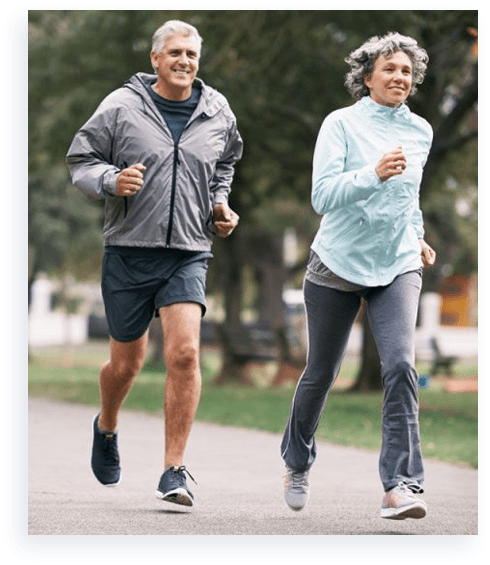Using Exercise
to Improve
YOUR JOINTS
We all know that exercising helps to improve a variety of different conditions. It helps with your heart, aids in maintaining healthy blood sugar levels and can also help to prevent chronic diseases such as diabetes, heart disease and cancer. But did you know it also helps with your joints? Joints are a critical part of our bodies because they allow us to be able to move around in our daily lives.
Exercising your joints has many benefits:
 Prevents joint pain and stiffness.
Prevents joint pain and stiffness. Increases your flexibility and strength.
Increases your flexibility and strength. Builds muscle surrounding your joints to help protect them.
Builds muscle surrounding your joints to help protect them. Increases blood flow to joints to allow oxygen and nutrients to circulate in those areas.
Increases blood flow to joints to allow oxygen and nutrients to circulate in those areas. Lubricates your joints and reduces swelling.
Lubricates your joints and reduces swelling. Maintains a healthy weight. This is important as excess body weight can cause stress on the joints and can lead to joint pain.
Maintains a healthy weight. This is important as excess body weight can cause stress on the joints and can lead to joint pain.
Exercises for Your Joints
There are many different types of exercise routines that can bet implemented to improve your joint health overall. From workouts that improve muscle strength and flexibility to ones that will increase blood flow to your joints, exercising will help to keep your joints and your overall health in shape.

Tips for
Implementing
Physical Activity
 Avoid exercising the same muscle groups two days in a row.
Avoid exercising the same muscle groups two days in a row. Implement rest days in between workouts to avoid joint pain.
Implement rest days in between workouts to avoid joint pain.  Listen to your body! If you feel pain or stiffness on the days you usually workout, skip it and rest!
Listen to your body! If you feel pain or stiffness on the days you usually workout, skip it and rest! Don’t overdo it! Over-exercising can lead to further joint damage.
Don’t overdo it! Over-exercising can lead to further joint damage. Move gently and slowly. If you are new or getting back into a workout regimen you may feel sore or some stiffness at first, but as you continue, your body should be getting stronger and feeling better after.
Move gently and slowly. If you are new or getting back into a workout regimen you may feel sore or some stiffness at first, but as you continue, your body should be getting stronger and feeling better after. Ice your joints after exercising if needed. This will reduce swelling on your joints. This should be applied for up to 20 minutes.
Ice your joints after exercising if needed. This will reduce swelling on your joints. This should be applied for up to 20 minutes.

Of course, with any new exercise program, it is important to discuss a plan with your doctor to ensure that certain exercises are right for you.
All in all, exercising can have tremendous benefits for the joints especially for anyone who may be suffering from joint pain. Engaging in physical activity is the best thing you can do for your body.
Whether it be a full-on weight training workout or doing yard work, exercising and moving your joints daily will help you to gain a healthy body and will allow you to live your life to the fullest.
InvigoFlex® Products

InvigoFlex® GS
Shellfish Free Glucosamine Sulfate

InvigoFlex® CS
Chondroitin Sulfate

InvigoFlex® AMPM
A Day & Night Joint Supplement

InvigoFlex® D
Classic Glucosamine Sulfate
References
1. Exercise and arthritis. American College of Rheumatology.
http://www.rheumatology.org/practice/clinical/patients/diseases_and_conditions/exercise.asp.
Accessed May 13, 2021.
2. How do exercise and arthritis fit together? (2020, December 01). Retrieved May 13, 2021, from
https://www.mayoclinic.org/diseases-conditions/arthritis/in-depth/arthritis/art-20047971
*These statements have not been evaluated by the Food & Drug Administration.This product is not intended to diagnose, treat, cure or prevent any disease.